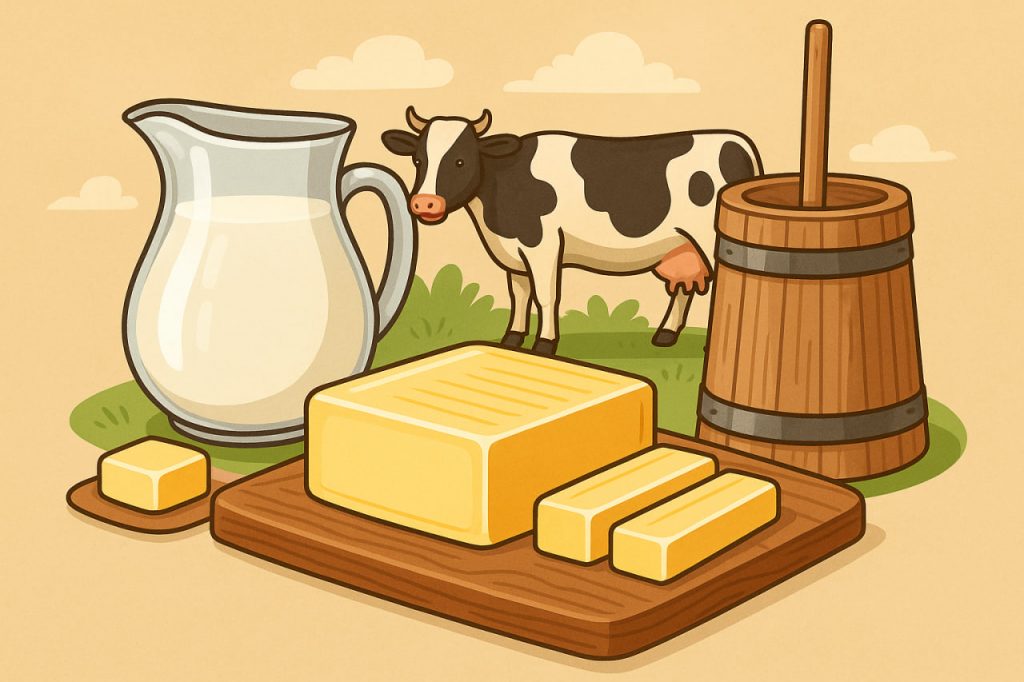Butter is one of the oldest dairy products, used in cooking for thousands of years. With its rich taste, creamy texture, and versatility, it remains a staple in many cuisines. However, like any food, butter has both nutritional benefits and potential health risks, depending on how it is consumed.
How Butter Is Made
- Milk collection – Butter is made from cow’s milk (sometimes goat, sheep, or buffalo).
- Cream separation – The fatty part of milk (cream) is separated using centrifuges.
- Churning – Cream is churned until fat globules clump together, separating from the liquid (buttermilk).
- Washing and kneading – The butter is washed, kneaded, and sometimes salted to improve flavor and preservation.
- Packaging – The final product is shaped into blocks or spreads.
This simple yet precise process has been modernized but remains based on traditional techniques of churning cream.
Nutritional Composition of Butter
- Fat (80–82%) – mostly saturated fat, which gives butter its solid form.
- Vitamins – especially A, D, E, and K2, fat-soluble vitamins important for vision, bones, and immunity.
- Conjugated linoleic acid (CLA) – found in grass-fed butter, may have anti-inflammatory properties.
- Butyrate – a short-chain fatty acid beneficial for gut health.
Benefits of Butter
- Rich source of energy – High in calories, useful for people needing quick energy.
- Vitamin content – Supports eye health, immune system, and bone strength.
- Better absorption of nutrients – Fat helps absorb fat-soluble vitamins from other foods.
- Flavor and culinary value – Adds taste, texture, and aroma to dishes.
- Natural product – Unlike some margarines, real butter is minimally processed.
Risks of Butter
- High in saturated fats – Excess consumption may raise cholesterol and increase risk of heart disease.
- Calorie-dense – Can contribute to weight gain if eaten in large amounts.
- Lactose and milk protein content – May cause problems for people with intolerance or allergies.
- Salted butter – Contains added sodium, which can raise blood pressure.
Butter vs Alternatives
- Margarine – Often contains trans fats (harmful to heart health), though modern versions may be healthier.
- Plant-based oils (olive, avocado, coconut) – Provide unsaturated fats, generally considered healthier for regular use.
- Ghee (clarified butter) – Popular in Indian cuisine, contains less lactose and more stable fats for high-heat cooking.
Moderation Is Key
Butter can be part of a balanced diet if consumed in small amounts. Choosing grass-fed or organic butter provides more vitamins and beneficial fatty acids. However, replacing excessive butter with plant-based oils is recommended for long-term cardiovascular health.
Conclusion
Butter is both a nutritional food and a culinary treasure. It provides essential vitamins and flavor but should be eaten in moderation due to its high saturated fat and calorie content. Balanced use, alongside healthier oils, allows people to enjoy butter’s benefits without increasing health risks.
Glossary
- Churning – the process of shaking cream to separate butterfat from buttermilk.
- Saturated fat – type of fat that is solid at room temperature, found in animal products.
- CLA (Conjugated Linoleic Acid) – a fatty acid with potential health benefits.
- Butyrate – a fatty acid that supports gut health.
- Trans fats – unhealthy fats formed during processing of oils, linked to heart disease.


